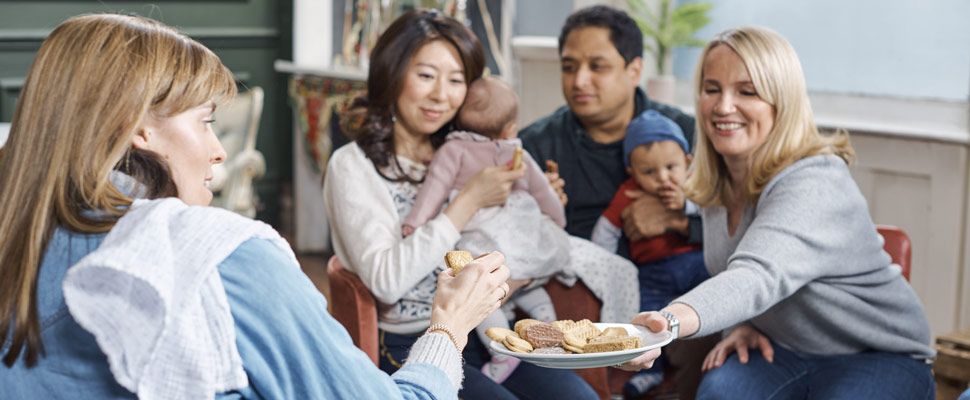There are many different types of slings or carriers on the market these days it can be quite confusing, some are simple wraps and some have clips and buckles. Rather than buying one and it not quite working resigned to the back of the cupboard why not try one, two or more from us to see which works best for you and your child

SLING/CARRIER LIBRARY
There are many different types of slings or carriers on the market these days it can be quite confusing, some are simple wraps and some have clips and buckles. Rather than buying one and it not quite working resigned to the back of the cupboard why not try one, two or more from us to see which works best for you and your child.
From newborn to toddler to preschooler - we have a selection or slings or carriers as they are known as part of our branch sling library to try out so you can try a few different types at low cost before spending money on buying your own. at just £12 for 4 week hire.Note: Card details are to be given at point of hiring in case of non-return or damage etc. Sling hire is very busy so to make is easier for you and us you can browse the inventory we hold online so you have an idea of what is available and even reserve a sling for hire if you know exactly what you want. If you register on the site before coming to hire a sling this makes it easier 'on the day' to complete the 'paperwork' required ( Name address etc) rather than having to fill lots of detail in on a smart phone.
Additional volunteers to help would also be welcomed, to relieve the load on the few we have and increase the number of events we can attend.
Find us on Facebook
BABYWEARING
Babywearing is the practise of wearing or carrying your baby or child in some form of sling/carrier. Babywearing is something that has been practised for centuries long before buggies or prams came along!
Benefits of babywearing include:
• Mothers' oxytocin is increased through physical contact with the infant, leading to a more intimate maternal bond, easier breastfeeding and better care, thus lowering the incidence of postpartum depression and psychosomatic illness in the mother.[2]
• Infants who are carried are calmer because all of their primal/survival needs are met. The caregiver can be seen, heard, smelled, touched, tasted, provide feeding and the motion necessary for continuing neural development, gastrointestinal and respiratory health and to establish balance (inner ear development) and muscle tone is constant.[3]
• Infants are more organized. Parental rhythms (walking, heartbeat, etc.) have balancing and soothing effects on infants.
• Infants are "humanized" earlier by developing socially. Babies are closer to people and can study facial expressions, learn languages faster and be familiar with body language.[4] • Independence is established earlier.[3]
• Attachment between child and caregiver is more secure.[5]
• Decreases risk of positional plagiocephaly ("flat head syndrome") caused by extended time spent in a car seat and by sleeping on the back. Sleeping on the back is recommended to decrease the risk of SIDS. Cranial distortion resulting from non-vehicular time in car seats has shown to be more severe than in children who develop plagiocephaly from back-lying on a mattress.[6]
Studies of parent-child attachment, parental satisfaction and infant crying all point to babywearing as an ideal solution for most parents to provide an optimum environment for attachment between parent and child. Baby carriers and slings help increase the number of hours of day an infant is held, and there is an inverse relationship between the number of hours spend crying and the number of hours a child is held in a given day. Even 3 hours per day of babywearing reduces infant crying significantly, and at 13 months, babies who have been in soft carriers regularly are significantly more likely to be securely attached than babies who are carried in hard carriers.[8]
References
- Blois, M, MD. (2005). Babywearing: The Benefits and Beauty of This Ancient Tradition. Pharmasoft Publishing.
- "Regulation of anxiety during the postpartum period", Lonstein, Joseph S., Frontiers in Neuroendocrinology, Volume 28, Issues 2-3, August–September 2007, Accessed 2009-05-09
- Morris, D. (1992). What Comforts a Baby? In Babywatching (pp 80-82). New York: Crown Publishers Inc.
- Kitzinger, Sheila. (1989). The Crying Baby. Penguin Books.
- Anisfeld, E., Casper, V., Nozyce, M., & Cunningham, N. (Oct., 1990). Does Infant Carrying Promote Attachment? An Experimental Study of the Effects of Increased Physical Contact on the Development of Attachment. Child Development, Vol. 61, No. 5, 1617-1627.
- Littlefield, Timothy R. "Car Seats, Infant Carriers, and Swings: Their Role in Deformational Plagiocephaly," Journal of Prosthetics & Orthotics 15, no. 3 (2003): 102-106.


